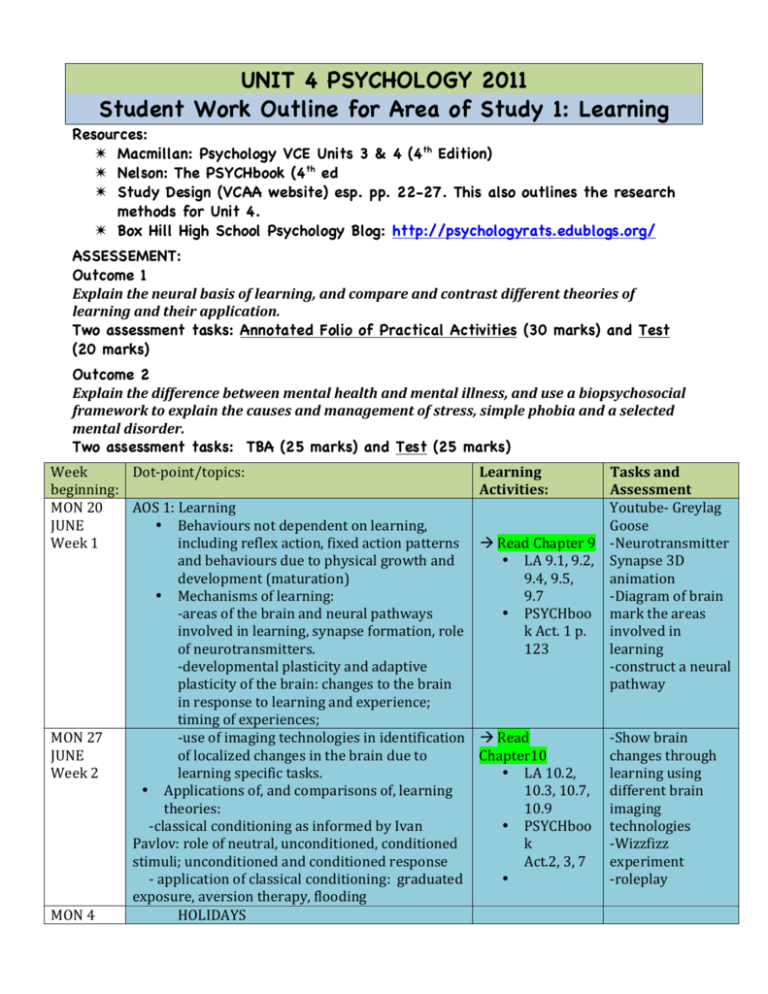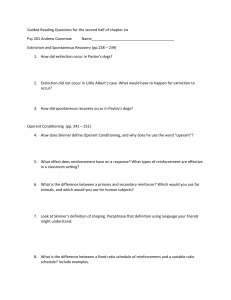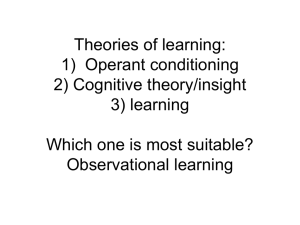UNIT 4 PSYCHOLOGY 2011 Student Work Outline for Area of Study
advertisement

UNIT 4 PSYCHOLOGY 2011 Student Work Outline for Area of Study 1: Learning Resources: Macmillan: Psychology VCE Units 3 & 4 (4th Edition) Nelson: The PSYCHbook (4th ed Study Design (VCAA website) esp. pp. 22-27. This also outlines the research methods for Unit 4. Box Hill High School Psychology Blog: http://psychologyrats.edublogs.org/ ASSESSEMENT: Outcome 1 Explain the neural basis of learning, and compare and contrast different theories of learning and their application. Two assessment tasks: Annotated Folio of Practical Activities (30 marks) and Test (20 marks) Outcome 2 Explain the difference between mental health and mental illness, and use a biopsychosocial framework to explain the causes and management of stress, simple phobia and a selected mental disorder. Two assessment tasks: TBA (25 marks) and Test (25 marks) Week Dot-­‐point/topics: beginning: MON 20 AOS 1: Learning JUNE • Behaviours not dependent on learning, Week 1 including reflex action, fixed action patterns and behaviours due to physical growth and development (maturation) • Mechanisms of learning: -­‐areas of the brain and neural pathways involved in learning, synapse formation, role of neurotransmitters. -­‐developmental plasticity and adaptive plasticity of the brain: changes to the brain in response to learning and experience; timing of experiences; MON 27 -­‐use of imaging technologies in identification JUNE of localized changes in the brain due to Week 2 learning specific tasks. • Applications of, and comparisons of, learning theories: -­‐classical conditioning as informed by Ivan Pavlov: role of neutral, unconditioned, conditioned stimuli; unconditioned and conditioned response -­‐ application of classical conditioning: graduated exposure, aversion therapy, flooding MON 4 HOLIDAYS Learning Activities: Read Chapter 9 • LA 9.1, 9.2, 9.4, 9.5, 9.7 • PSYCHboo k Act. 1 p. 123 Tasks and Assessment Youtube-­‐ Greylag Goose -­‐Neurotransmitter Synapse 3D animation -­‐Diagram of brain mark the areas involved in learning -­‐construct a neural pathway Read Chapter10 • LA 10.2, 10.3, 10.7, 10.9 • PSYCHboo k Act.2, 3, 7 • -­‐Show brain changes through learning using different brain imaging technologies -­‐Wizzfizz experiment -­‐roleplay JULY TO 15 JULY MON 18 JULY Week 3 MON25 JULY Week 4 MON 1 AUG Week 5 MON 8 AUG Week 6 -­‐three-­‐phase model of operant conditioning as informed by B.F.Skinner: positive and negative reinforcement, response cost, punishment and schedules of reinforcement. -­‐applications of operant conditioning: shaping, token economies. -­‐comparison of classical and operant conditioning in terms of the processes of acquisition, extinction, stimulus generalization, stimulus discrimination, spontaneous recovery, role of learner, timing of stimulus and response and nature of response (reflexive/ voluntary) -­‐one-­‐trial learning with reference to taste aversion as informed by John Garcia and Robert A Koelling (1966) -­‐trial and error learning as informed by Edward Lee Thorndike’s puzzle-­‐box experiment. -­‐Observational learning (modeling) processes in terms of the role of attention, retention, reproduction, motivation, reinforcement as informed by Albert Bandura’s (1961, 1963a, 1963b) -­‐Insight learning as informed by Wolfgang Kohler -­‐Latent learning as informed by Edward Tolman. • • The extent to which ethical principles were applied to classic research investigations into learning, including John Watson’s ‘Little Albert’ experiment. Research methods and ethical principles associated with the study of learning as outlined in the introduction to the unit. Read p.479-­‐ 507 * LA 10.12, LA 10.13, 10.14, 10.17, 10.22, * PSYCHbook Act 5, p.130 Read p.503-­‐507 p.476-­‐478 p.460-­‐463 and 494-­‐496 * LA 10.2110.4, 10.5, 10.24, 10.11, 10.27, 10.28 *PSYCHbook Act.6 -­‐Role play shaping and token economy. -­‐Present the schedules of partial reinforcement -­‐ Venn diagram -­‐ Learning (Zimbardo) -­‐ Build a puzzle box READ p.509-­‐ 529 • PSYCHboo k Act.9 • LA 10.30,10.3 1, 10.32, 10.33, 10.34,10.3 7, 10.38,10.3 9 • Read467-­‐ 469 • Chapter 1 • LA 10.8 Analyse Bandura’s BoBo Doll experiment SAC 1 due: Annotated Folio SAC 2: Test Learning. ***UNIT 4 EXAMS Monday 7th November*** Notes on Exam: Duration is 90 minutes + 15 minutes reading time Each exam comprises 33% of final assessment Three compulsory sections: Section A: Multiple-­‐Choice questions and Section B: Short-­‐answer questions and Section C: Extended Response Question Each exam will contain one extended response question worth approx. 10-­‐15 marks Separate areas of study will not be flagged in the exams









